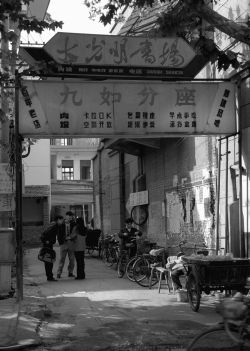Elements of Performance (2)

The storytellers' house—'the place'
Yangzhou storytellers' expressions related to the setting against which a performance takes place are here treated under the heading: the place changzi. This is the common designation for the actual physical place where storytelling is performed for an audience. The full form of the word is "storytelling place" shuchangzi, usually translated as "storytellers' house". It is an establishment where an audience of considerable size (between one and five hundred people) can be seated indoors and served tea while listening to the storyteller who is usually performing from a small platform. Many teahouses also served formerly as storytellers' houses, but in such places the serving of tea and food was the primary function, storytelling an additional entertainment. In its specific geographic and historical setting, the storytellers' house exemplifies the performance arena of oral tradition in China in one of its most characteristic forms.
There used to be more than twenty storytellers' houses and teahouses offering storytelling in Yangzhou. The storytellers would alternate between these places, usually working for a period of three months at one place. Often they would take to the roads and accept jobs in other towns and villages all over the area north and south of the Yangzi River where the dialect is spoken, including teahouses in Nanjing and Shanghai, "touring the market towns" pao matou. Such was the situation when the older generation of storytellers who are now in their sixties or seventies were young. Presently there is only one place in Yangzhou city, the "Great Enlightenment Storytellers' House" Da guangming shuchang, where storytelling is regularly performed in daily sessions of a couple of hours. Similar developments have taken place all over the area. The drastic reduction in number of "houses" is just one indication of the dramatic change that has occurred in the storytellers' life conditions during the twentieth century.
The storytellers' houses and teahouses had private owners changdong well into the 1960s, when most places were gradually closed. During the Cultural Revolution (1966-1976) the storytellers were not allowed to perform their traditional themes and activity was scarce. It took almost another ten years before a new storytellers' house was made available for performances in 1986, the above mentioned Da guangming shuchang, which is under collective ownership. Terms concerning the storytellers' house are reminiscent of the time when there were many of them in the neighborhood and competition was stiff. A storytellers' house where performances were seldom and the audience scarce was called a "cold place" leng changzi , while a house where storytellers followed one another without interruption and the audience was steady and ample, was called a "hot place" re changzi. A house that was well situated and where it was easy to attract a large audience, was called "a decent place" zhengmian changzi, the opposite of a house, situated out of the way and called "on the border" bianchui.
Video:
Storytellers house
video mpeg 9Mb
video wmv 2.7Mb